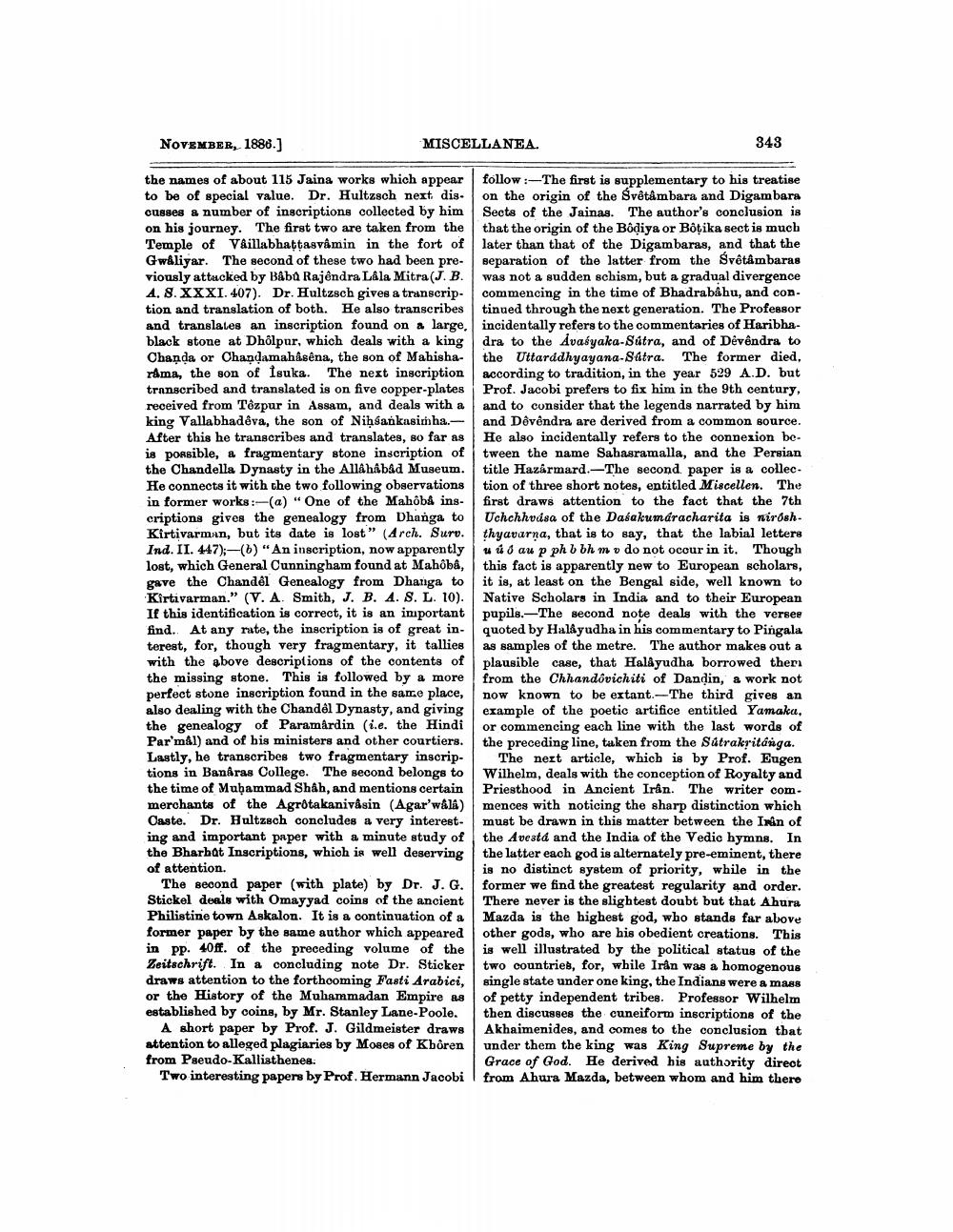________________
NOVEMBER, 1888.]
MISCELLANEA.
343
the names of about 115 Jaina works which appear follow :-The first is supplementary to his treatise to be of special value. Dr. Hultzsch next dis. on the origin of the Svêtâmbara and Digambara cusses a number of inscriptions collected by him Sects of the Jainas. The author's conclusion is on his journey. The first two are taken from the that the origin of the Bodiya or Bôţika sect is much Temple of V&illabhattasvâmin in the fort of later than that of the Digambaras, and that the GwAliyar. The second of these two had been pre- separation of the latter from the Svêtâmbaras viously attacked by Baba Rajêndra Lala Mitra(J. B. was not a sudden schism, but a gradual divergence A. 8. XXXI. 407). Dr. Hultzsch gives a transcrip- commencing in the time of Bhadrabahu, and contion and translation of both. He also transcribes tinued through the next generation. The Professor and translates an inscription found on a large, incidentally refers to the commentaries of Haribhablack stone at Dholpur, which deals with a king dra to the Avakyaka Sútra, and of Devendra to Chanda or Chandamahåsena, the son of Mahisha- the Uttarddhyayana-Satra. The former died, ráma, the son of Isuka. The next inscription according to tradition, in the year 529 A.D. but transcribed and translated is on five copper-plates Prof. Jacobi prefers to fix him in the 9th century, received from Tôzpur in Assam, and deals with a and to consider that the legends narrated by him king Vallabhadeva, the son of Nihsankasimha. and Dêvêndra are derived from a common source. After this he transcribes and translates, so far as He also incidentally refers to the connexion beis possible, a fragmentary stone inscription of tween the name Sahasramalla, and the Persian the Chandella Dynasty in the Allahabad Museum. title Hazármard.—The second paper is a collecHe connects it with the two following observations tion of three short notes, entitled Miscellen. The in former works :-(a) “One of the Mahoba ins- first draws attention to the fact that the 7th criptions gives the genealogy from Dhanga to Uchchhudsa of the Daśakumdracharita is nirghKirtivarman, but its date is lost" (Arch. Surv. thyavarna, that is to say, that the labial letters Ind. II. 447);—(6) "An inscription, now apparently u ú8 au p ph b bh m d do not ocour in it. Though lost, which General Cunningham found at Mahộba, this fact is apparently new to European scholars, gave the Chandel Genealogy from Dhanga to it is, at least on the Bengal side, well known to Kirtivarman.” (V. A. Smith, J. B. A. S. L. 10). Native Scholars in India and to their European If this identification is correct, it is an important pupils.-The second note deals with the versee find. At any rate, the inscription is of great in- quoted by Halayudha in his commentary to Pingala terest, for, though very fragmentary, it tallies as samples of the metre. The author makes out a with the above descriptions of the contents of plausible case, that Halayudha borrowed therı the missing stone. This is followed by a more from the Chhandôvichiti of Dandin, a work not perfect stone inscription found in the same place, now known to be extant.--The third gives an also dealing with the Chandel Dynasty, and giving example of the poetic artifice entitled Yamaka, the genealogy of Paramárdin (i.e. the Hindi or commencing each line with the last words of Par'mal) and of his ministers and other courtiers. the preceding line, taken from the Sútrakritánga. Lastly, he transcribes two fragmentary inscrip- The next article, which is by Prof. Eugen tions in Bandras College. The second belongs to Wilhelm, deals with the conception of Royalty and the time of Muhammad Shah, and mentions certain Priesthood in Ancient Iran. The writer com. merchants of the Agrðtakanivåsin (Agar'wala) mences with noticing the sharp distinction which Caste. Dr. Hultzsch concludes a very interest- must be drawn in this matter between the Irin of ing and important paper with a minute study of the Avesta and the India of the Vedic hymns. In the Bharbat Inscriptions, which is well deserving the latter each god is alternately pre-eminent, there of attention.
is no distinct system of priority, while in the The second paper (with plate) by Dr. J. G. former we find the greatest regularity and order. Stickel deals with Omayyad coins of the ancient There never is the slightest doubt but that Ahura Philistine town Askalon. It is a continuation of a Mazda is the highest god, who stands far above former paper by the same author which appeared other gods, who are his obedient creations. This in pp. 40ff. of the preceding volume of the is well illustrated by the political status of the Zeitschrift. In a concluding note Dr. Sticker two countries, for, while Irån was a homogenous draws attention to the forthooming Fasti Arabici, single state under one king, the Indians were a mass or the History of the Muhammadan Empire as of petty independent tribes. Professor Wilhelm established by coins, by Mr. Stanley Lane-Poole. then discusses the cuneiformo inscriptions of the
A short paper by Prof. J. Gildmeister draws Akhaimenides, and comes to the conclusion that attention to alleged plagiaries by Moses of Kbören under them the king was King Supreme by the from Pseudo-Kallisthenes.
Grace of God. He derived his authority direot Two interesting papers by Prof. Hermann Jacobi from Ahura Mazda, between whom and him there




